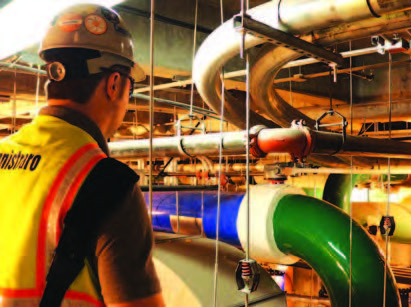
To upgrade the water systems at the University of Massachusetts Boston’s central utility plant—in a single weekend and without disrupting any other system functions—J.C. Cannistraro put to work the Autodesk® Fabrication CADmep™ system it has used since 2003.
Thanks to building information modeling (BIM) and prefabrication technologies, Cannistraro installed in one day the temporary systems it needed to ensure a smooth transition for the rest of the project.
“Given our limited time to install the temporary systems and the large number of systems we had to connect, BIM-enabled prefabrication was a perfect fit on this job,” said Cannistraro’s project manager Eric Beck. “We used Fabrication CADmep software to create 3D models of the existing plant, the temporary systems, and the new systems. This helped us coordinate the new HVAC systems and hangers with the existing connections and services and prefabricate a tremendous amount of work.”
The project was part of a major infrastructure overhaul involving the development of a new utility corridor and roadway network for the 175-acre campus overlooking Boston Harbor. As part of the project, the school’s existing 40-year old central utility plant will be upgraded to a more energy-efficient primary and secondary pumping arrangement to serve the campus’ hot and chilled water utility loop. The upgrade includes four 2,000-ton centrifugal chillers, three 800-horsepower hot water boilers, and one 400-horsepower hot water boiler. The new hot water system has piping sizes up to 16” in diameter and the chilled water system has piping up to 30”.
Keeping Campus Up and Running
“The campus operates 24 hours a day, all year long, which complicated the logistics of the project and installations,” explained Beck. “To keep the campus running, we had to install temporary chillers and repipe the 400-horsepower boiler to serve the campus while the balance of the heating plant was upgraded.” The installations had to be done within a very small window: a weekend in the spring to install system isolation valves for both the 400-horsepower boiler and 30” chilled water valves to isolate the campus/temporary chillers from the central utility plant’s chiller piping upgrades.
Furthermore, many services running through the plant were not affected by the HVAC update. These systems—including electrical, domestic water, and fire protection—had to remain undisturbed while the HVAC systems were upgraded. “We had to fit a large amount of substantially-sized piping through this maze of existing services, without reliable as-built documentation for the plant,” said Beck.
Tight Quarters
In addition, the existing plant is below ground and features concrete construction, including the roof. “We were not permitted to attach hanger rods to the underside of the deck, only to the sides of the concrete beams that were supporting the deck,” said Colin Detra, Cannistraro’s HVAC coordinator on this project. “This limited our pipe hanger locations, requiring careful layout of the new piping systems.”
“With support from [Autodesk] Fabrication CADmep software, it took half the time to create [several hundred spool] sheets than it would using 2D drafting software, and the quality is better.”
— Colin Detra, HVAC Coordinator, J.C. Cannistraro
Virtual Layout and Coordination
Instead of traditional tape measures and plumb bobs, Cannistraro captured the existing conditions of the plant with laser scanning technology. “I used the resulting point cloud as a reference to build a model of the existing plant, turning everything (from 3/4” conduits to 30” chilled water piping) into 3D objects,” said Detra. “Then I used this model and the software’s 3D modeling environment to precisely layout all the new systems—more effectively coordinating the 50-plus connections and finding suitable locations for the hanger rods, while helping avoid interferences with existing services.”
Cannistraro also used the Fabrication CADmep software model to help virtually plan and coordinate demolition and installation, phase by phase. “For example, while we installed the hot water systems, we knew the chilled water piping would still be there,” said Detra. “So in our planning model, I displayed the new hot water and existing chilled water systems, as well as all unaffected services, to verify the layout and minimize clashes during installation. Later on, I did the same thing to route the new chilled water system—toggling off the old chilled water system and toggling on the new hot water piping and unaffected services.”
Beck noted, “We use prefabrication whenever possible. It gives us a controlled environment and lets us perform months of work beforehand—helping to increase project quality and safety while minimizing project cost and schedule.” Fabrication CADmep software plays a critical role, helping Cannistraro automatically produce intelligent shop drawings from the project model with the necessary detail for fabrication, including manufacturer-specific content and components.
“We generated several hundred spool sheets for this project,” said Detra. “With support from Fabrication CADmep software, it took half the time to create these sheets than it would using 2D drafting software, and the quality is better.” In addition, the Fabrication CADmep software model has the intelligent data to drive automated welding machines, translating to almost 9,500” of X-ray-quality welding on this job.
Beating the Clock
The project is currently in the late stages of completion. “For the temporary installations, we didn’t even need the whole weekend,” said Detra. “We had the systems installed and running within a day.”
“We pay attention to details and strive to be the professional standard for quality and reliability in mechanical construction,” said Beck. “Autodesk Fabrication CADmep software helps us achieve that goal. We are more accurate, efficient, and deliver more innovative building strategies.”
For more information about Autodesk Fabrication software, visit www. autodesk.com/fabrication.


